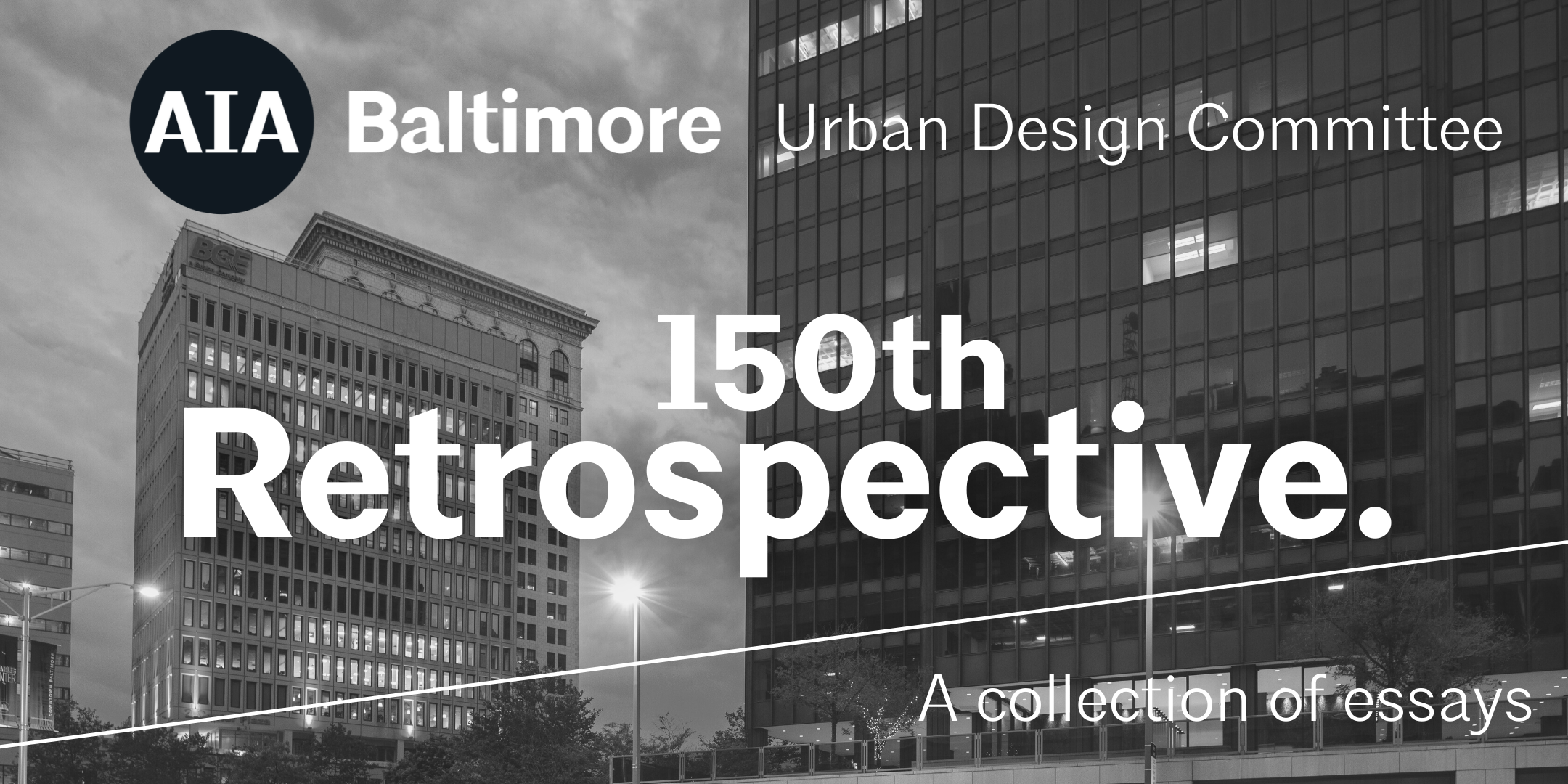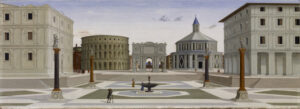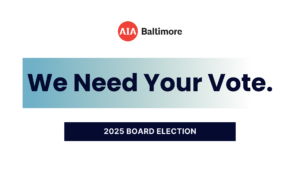An Interview with Jim Brown, Director of Trail Nation, Rails to Trails Conservancy
By: Ren Southard, Associate AIA, Co-Chair Urban Design Committee | AIA Baltimore
As we celebrate the history of AIA Baltimore and the Urban Design Committee (UDC), members have been contemplating what purpose the committee served in the past, and what role it will have in the coming years. We have been reaching out beyond UDC members, as well, to ask, “What role does UDC play in Baltimore, with other organizations?”
To answer this question, we turned to Jim Brown, Director of Trail Nation, Rails to Trails Conservancy. Jim’s first encounter with AIA Baltimore’s Urban Design Committee was in 2018. He and Avery Harmon were working together for the Rails-to-Trails Conservancy, and were focusing on an effort called the Baltimore Greenway Trails Coalition. The Baltimore Greenway Trails Coalition is an ongoing effort that “seeks to create a 35-mile world-class network of urban trails that link together the diverse neighborhoods, cultural amenities and outdoor resources that make up the landscape of Baltimore City. When complete, the trail network will connect the city’s anchor institutions and destinations—including universities, hospitals, museums, parks, schools, waterfronts and employment centers—with Baltimore’s diverse communities. The trail network will transform the public realm by providing equitable, healthy, low-stress access to open space and reliable transportation and recreation for people of all ages and abilities. This modern-day trail vision is inspired by the 1904 Olmsted Plan for Baltimore, which called for creating a network out of the city’s vast amounts of public parkland. Today, we have identified new opportunities in the built environment to bring this vision to reality.”
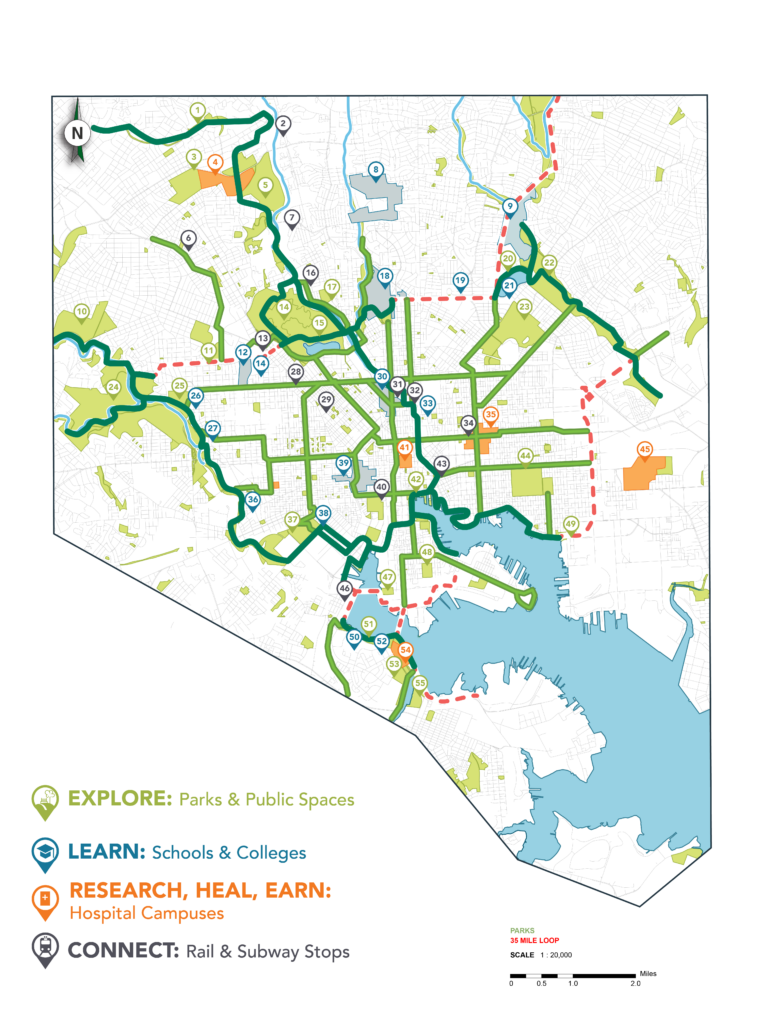
Above: A working draft of the trail map developed by members of the Urban Design Committee intended to show the many important places connected by the 35-mile Baltimore Greenway Loop
Ren Southard was a brand new co-chair of the committee, and had met Avery at one of the meetings. Avery, being a natural connector and realizing they worked from the same office space at the Impact Hub in Station North, set up an initial meeting to discuss the possibility of a collaborative effort between Rails-to-Trails and UDC. Rails-to-Trails was in the coalition-building phase of the project. The Baltimore Greenway is part of a larger plan called the Baltimore Green Network, which had been a years-long planning effort and was about to be adopted by the Baltimore City Planning Commission. Jim and Avery were still in the process of weaving together ideas from the plan, and thinking about how to build support for the project. It was a messy phase of the project with the Mayor’s Office in transition, but Tom Stossur, the Planning Director at the time, believed strongly in bringing the Green Network to life.
As the Project Manager of Baltimore Greenway, Jim was interested in communicating positive impacts the project could have to residents. He needed tools that would illustrate to communities what the Baltimore Greenway could look like, that it was for people of all ages and abilities – not just bicycles, but a linear park that connected people with places, with each other. Unfortunately, budgets were tight and limited grant funding was reserved for portions of the trail that were buildable in the city right-of-way. No spending was available for “dreaming” about the multiple additional trail corridors on privately-owned parcels that make up a portion of the plan. Lacking official buy-in and communication tools the neighborhoods could understand, Jim decided to try working with UDC. Jim recognized the potential thoughtful Urban Designers and Baltimore advocates could bring to the project. Their contributions could help raise the profile of the Greenway and bridge the resource gap the project had (and still has). Jim was also happy for the promise of pro-bono urban design services, but recognizing that a group of busy professionals volunteering their time on weeknights and weekends might not work out, he reserved his expectations. Even Ren questioned whether the effort would produce results or simply become another project that never made it off the shelf.
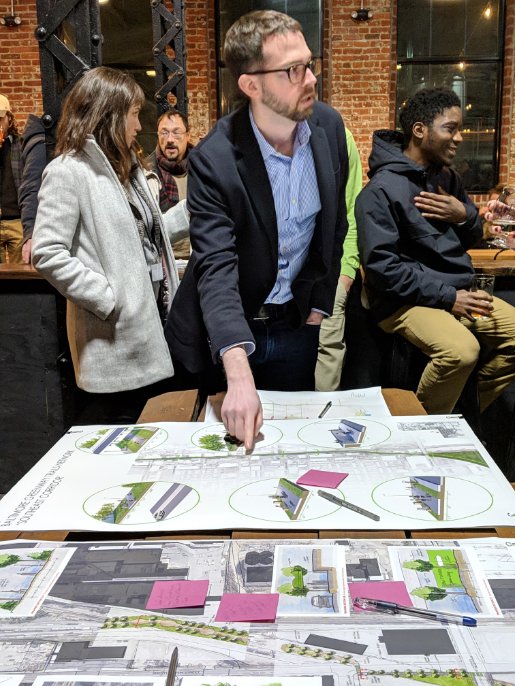
Above: A community workshop was held January 19th, 2019 at Monument City Brewing. Sam Lynch (center) explains concept designs and solicits feedback. Ren Southard (left) and Avery Harmon (seated) discuss ideas with residents and trail advocates.
Good intentions don’t always yield good results, but after several meetings at the Impact Hub with a spin-off sub-committee led by co-chair Sam Lynch, the group started to grow. Members cycled in and out as they had time, but the dedicated efforts paid off. The group made site visits to portions of the trail – in some cases, overgrown railroad rights of way. They held neighborhood outreach events in which they shared images of what the Greenway could someday be and gathered community feedback. They made maps, and thought about marketing strategies. David Benn, AIA, became a champion of the project, writing opinion pieces and recruiting staff at his firm to help with design. Jim was pleased with the opportunity to engage UDC and the resulting deliverables. Of working together, he says, “The critical thinking about design and space are great, but also understanding the importance of renderings as communication tools for residents – these things may seem like just a drop in the bucket, but they tip the project toward reality. Images help people feel like it [the 35 mile Baltimore Greenway] is possible. The visualizations provided by UDC helped funders, elected leaders, and residents all get a better idea of what the Greenway may look like, and how they can be part of making it happen.” “UDC’s work helped Rails-to-Trails Conservancy, Baltimore City agencies and Greenway Coalition partners make the case for continued investment in the Greenway from federal, state, local, private and philanthropic sources. The graphics helped people understand the project is real, and UDC’s work was leveraged to assist with property donations, grant funding, community meetings and so much more”

Above: A community workshop held July 23rd, 2019 at Mobtown Brewery. Jim Brown and Brant Fisher of Brewers Hill Neighbors Inc. (far right) address a room full of community members and trail advocates.
Jim and UDC will continue to work together on the Baltimore Greenway project. Avery moved on, leaving Baltimore to attend graduate school at University of Pennsylvania, and his role was taken up by a new valuable team member, Ethan Abbott. The members of the UDC have also changed, but Sam continues to lead the sub-committee in their important work. Currently, the group is planning an outdoor (safely distanced) community charrette, and working on updated marketing materials including a few schematic design ideas for unbuilt sections of the trail. Together, the group plans to move ahead, while remembering and appreciating how those who have been involved help to mold the project and make it their own.
